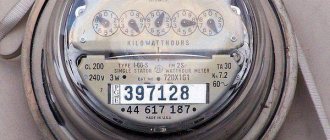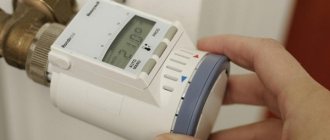To account for consumed electricity, individual and communal meters are used. Federal Law No. 261-FZ regulates the installation of ODPU in apartment buildings and public utilities to account for the consumption of electricity spent on general needs (external lighting, ensuring the operation of elevators, etc.). and to identify facts of illegal connection to the power grid. Installation of a common house meter must be carried out at the expense of the consumer (real estate owner).
What is a communal electricity meter?
Devices of this type can be either two-tariff or multi-tariff.
You can reduce the cost of lighting a common area using a multi-tariff meter. Its installation pays off in a short time, despite the high cost. Programming of metering devices is carried out according to the following tariff plans:
- night – from 23-00 to 7-00;
- half-peak – from 10-00 to 17-00 and from 21-00 to 23-00;
- peak – from 7-00 to 10-00 and from 17-00 to 21-00.
The difference in readings between the amount of expenses for the apartments of a multi-storey building and the general meter is divided between the residents. Data reconciliation is carried out using receipts. If there is a sharp increase in general household consumption, an extraordinary inspection is necessary.
If there is an ODPU in the house, it is possible to fully automate the process of taking readings. This helps save money on service personnel and eliminates failures when charging subscription fees.
How to install or replace an electricity meter
Each apartment must be equipped with a metering device. The meter must be officially installed, then it will be registered and sealed by the energy supply company.
Replacement of the electric meter occurs upon mandatory notification of the resource supplier, but at the expense of the consumer. It is carried out in the following cases:
- planned work;
- malfunction;
- the end of the device's service life.
Installing and replacing electrical metering equipment requires basic knowledge and skills. You also need to comply with safety requirements, as well as a number of conditions in which the accuracy of the supplied meter will be maximum:
- the room must be dry;
- installation takes place at room temperatures from +20° to +40°C;
- the surface must be hard and not vibrate;
- The device must be installed on wooden, metal or plastic panels;
- it can only be mounted vertically;
- the angle of inclination should not exceed 1 degree;
- automatic switches should be made.
Since installing and replacing a three-phase meter is relevant for industrial enterprises, we will describe in detail the process of installing a single-phase device in residential premises.
The connection diagram for the electricity meter in the apartment is as follows.
The connection algorithm can be described as follows:
- Place all devices in the shield.
- Apply markings for the DIN rail and meter.
- Fix all components to the wall.
- Install circuit breakers on the rail.
- Connect the phase to the switches.
- Cut and strip the wire of insulating material.
- Insert the terminal and secure everything with fastening materials.
- Connect circuit breakers to the system.
- To output zero, take a wire of a contrasting color and measure the length from the copper plate to the meter.
- Clean the wires and secure them on both sides.
- Mount the shield.
- Drill holes in the wall and screw the structure onto self-tapping screws.
- Install grounding.
On the composition of common property
Payment for electricity by meter
In order to ensure safety and proper living conditions in an apartment building, lighting of common areas is provided. The electricity spent for general household needs must be taken into account for payment in favor of the electricity supply company.
Following the Rules for the maintenance of common property dated August 13, 2006 (according to Decree No. 491 of the Government of the Russian Federation), we will compile a list of the following objects.
- Premises located outside the residential area: halls, staircases and landings, elevator cabins, technical floors, basements, stroller rooms, boiler rooms, boiler rooms, electrical switchboards, workshops, garages, etc.;
- Roofing structures;
- Enclosing and load-bearing structures;
- Sanitary facilities, fire protection, ventilation shafts, bomb shelters;
- Adjacent territories, gates, entrances;
- Sports and children's playgrounds, car parks (in the area adjacent to the house), gatehouses.
The amount of general expenses may increase in case of unforeseen situations. For example, if in order to eliminate an accident or perform repair work it is necessary to use equipment that consumes electricity. In addition, changes in regulations that provide for increased electricity consumption should be taken into account.
ODPU must keep records of CG consumption separately for each house
The installation of such a heat metering device in houses should be carried out at the point where the MKD is connected to the centralized supply systems of energy resources (Part 1 of Article 13 No. 261-FZ). Let's consider this issue using the example of installing an electrical energy distribution system.
The volume of electricity must be determined by a common house metering device installed at the boundary between electrical grid facilities and in-house engineering systems of the apartment building, that is, at the boundary of the balance sheet between consumers and network organizations (clauses 138, 144 of RF PP No. 442).
The balance sheet boundary is the line of division of electric power facilities between owners on the basis of ownership, defining the boundary of operational responsibility between the network organization and the consumer for the condition and maintenance of electrical installations (clause 2 of RF PP No. 861).
Such a line of balance sheet ownership in an apartment building is the outer boundary of the wall of such a house, and the boundary of operational responsibility in the presence of an ODPU is the place of connection of such a meter with the utility networks included in the house (clause 8 of RF PP No. 491).
At the same time, if it is not possible to install a common house control panel on the border, then it is installed in a place as close as possible to such a border. This can also be done in the area of responsibility of another house (adjacent entity) by agreement of the parties (clause 144 of the RF PP No. 442).
The above norms and legal acts prove that it is necessary to install a common building control system for each apartment building separately. Consequently, accounting of CG consumption is carried out for each house.
Can the management authority charge residents an additional fee for replacing the ODPU
7689719
Installation procedure
How to take meter readings correctly
A common meter is installed in the electrical panel at the entrance to the house. Installation is carried out by specialists with appropriate permits and qualifications. The ODPU installation rules prescribe the following options for installing metering devices.
- At a meeting of the residents of the house, a decision is made to raise the necessary funds for the purchase and installation of a common house electricity meter. A decision made by a majority vote is binding on those who disagree. Activists should be made aware of the importance and economic viability of fundraising. Payment for installation work is made under the expense item for current repairs.
- In the event that the residents' council is not active, the management company makes an independent decision on allocating funds to the common meter. Partial financing is possible at the expense of the consumer or in installments.
- If there is inconsistency between the parties (the management company and the property owners), the energy supply organization develops rules according to which the general house electricity consumption will be taken into account in the future. The management company is provided with a document indicating the type of meter that will be installed. The energy supply organization carries out the installation on its own; expenses will be reimbursed by the homeowners. Installment plans with payment over 5 years are possible, but with interest agreed upon with the Central Bank of the Russian Federation.
Refusal to install a common house meter will entail sanctions provided for by the Administrative Code. Refusal by property owners to pay for the installation of an electricity meter may result in legal proceedings. The losing party pays the court costs.
Household electricity meter: who installs and who owns it in 2021
Questions have become more frequent regarding the reasons for management organizations to install communal meters for electricity consumed by an apartment building. This issue is being raised due to an increase in electricity bills, which are spent mainly on lighting common areas in an apartment building. It is for this reason that we provide clarifications to citizens on this issue and think that such clarifications should become a good tradition of our company.
The Housing Code of the Russian Federation, entered into force on March 1, 2005, in part 3 of Article 39 provides that the rules for maintaining common property in an apartment building are established by the Government of the Russian Federation.
In pursuance of the requirements of the federal legislator, Decree of the Government of the Russian Federation of August 13, 2006 N 491 approved the Rules for the maintenance of common property in an apartment building.
According to the Rules, the composition of common property includes:
a) premises in an apartment building that are not parts of apartments and are intended to serve more than one residential and (or) non-residential premises in this apartment building (hereinafter referred to as common areas), including inter-apartment landings, stairs, elevators, elevators and others shafts, corridors, strollers, attics, technical floors (including built-in garages and areas for vehicles, workshops, technical attics built at the expense of the owners of the premises) and technical basements in which there are utilities, otherwise serving more than one residential and (or) non-residential premises in an apartment building equipment (including boiler rooms, boiler rooms, elevator units and other engineering equipment);
c) enclosing load-bearing structures of an apartment building (including foundations, load-bearing walls, floor slabs, balcony and other slabs, load-bearing columns and other enclosing load-bearing structures);
d) enclosing non-load-bearing structures of an apartment building serving more than one residential and (or) non-residential premises (including windows and doors of common areas, railings, parapets and other enclosing non-load-bearing structures);
e) mechanical, electrical, sanitary and other equipment located in an apartment building outside or inside the premises and serving more than one residential and (or) non-residential premises (apartment);
f) a land plot on which an apartment building is located and the boundaries of which are determined on the basis of state cadastral registration data, with elements of landscaping and landscaping;
g) other facilities intended for the maintenance, operation and improvement of an apartment building, including transformer substations, heating points intended to serve one apartment building, collective parking lots, garages, children's and sports grounds located within the boundaries of the land plot on which the apartment building is located .
This regulatory legal act was published in the Collection of Legislation of the Russian Federation No. 34, August 21, 2006, Rossiyskaya Gazeta dated August 22, 2006.
The rules regulate relations regarding the maintenance of common property owned by the right of common shared ownership to the owners of premises in an apartment building, including indicating the requirements for the maintenance of such property, in particular: ensuring the constant readiness of utilities, metering devices and other equipment included in the common property, for the provision of utilities (supply of utility resources) to citizens living in an apartment building, in accordance with the Rules for the provision of utility services to citizens.
To ensure favorable and safe living conditions for citizens, proper maintenance of common property in an apartment building, resolving issues regarding the use of said property, as well as providing utilities to citizens living in an apartment building, the Housing Code of the Russian Federation provides for holding a general meeting of owners of premises in such a building, which chooses the method of managing an apartment building (clause 4 of part 2 of Article 33).
According to Part 2 of Article 161 of the Housing Code of the Russian Federation, owners of premises in an apartment building choose one of the methods of managing an apartment building: 1) direct management of the owners of premises in an apartment building; 2) management of a homeowners’ association or a housing cooperative or other specialized consumer cooperative; 3) management of the management organization.
Thus, managing a management organization is one of the ways to manage an apartment building.
According to part 7 of Art. 155 of the Housing Code of the Russian Federation, the owners of premises in an apartment building in which a homeowners' association or a housing cooperative or other specialized consumer cooperative has not been created and which is managed by a management organization, pay fees for residential premises and utilities to this management organization.
According to Part 1 of Art. 157 Housing Code of the Russian Federation
the amount of payment for utilities is calculated based on the volume of consumed utilities, determined by the readings of metering devices , and in their absence, based on the standards for the consumption of utilities approved by government bodies of the constituent entities of the Russian Federation in the manner established by the Government of the Russian Federation.
The Housing Code of the Russian Federation provides that owners of premises in an apartment building bear the burden of expenses for maintaining common property in an apartment building (Part 1 of Article 39).
According to part 5 of Art. 13 of the Federal Law of November 23, 2009 N 261-FZ “On energy saving and on increasing energy efficiency and on introducing amendments to certain legislative acts of the Russian Federation” until January 1, 2012, owners of premises in apartment buildings put into operation on the date of entry into force of this Federal law is required to ensure that such houses are equipped with metering devices for used water, natural gas, thermal energy, electrical energy, as well as putting the installed metering devices into operation. At the same time, apartment buildings within the specified period must be equipped with collective (common building) metering devices for used water, thermal energy, electrical energy, as well as individual and common (for a communal apartment) metering devices for used water, natural gas, and electrical energy.
According to Part 9 of Article 13 of the Federal Law of November 23, 2009 N 261-FZ “On energy saving and increasing energy efficiency and on introducing amendments to certain legislative acts of the Russian Federation”, from July 1, 2010, organizations that supply or transmit electrical energy and whose engineering and technical support networks are directly connected to the networks that are part of the engineering and technical equipment of an apartment building, are obliged to carry out activities for the installation, replacement, operation of metering devices for the energy resources used, the supply or transmission of which they carry out.
According to clause 7 of the Rules for the provision of utility services to citizens No. 307, approved on May 23, 2006, owners of premises in an apartment building pay a fee based on the readings of metering devices installed at the border of the networks that are part of the common property of the owners of premises in an apartment building. At the same time, the legislator does not indicate that installed metering devices should be the property of the owners of multi-apartment residential buildings.
According to clause 89 of the Government of the Russian Federation of August 31, 2006 N 530 (as amended on December 31, 2010) “On approval of the basic provisions for the functioning of retail electricity markets,” the utility service provider (management company) on the basis of an energy supply agreement (purchase and sale (supply) agreement ) electrical energy) and, in accordance with this document, purchases electrical energy from the guaranteeing supplier (energy sales organization) for the purpose of providing utility services for electricity supply to the owners and tenants of residential premises in an apartment building and for use for general house needs (lighting and other services using electrical energy of inter-apartment landings, stairs, elevators and other common property in an apartment building), as well as to compensate for electricity losses in intra-house electrical networks. In this case, the amount of electrical energy purchased by the contractor from the guaranteeing supplier (energy sales organization) is determined at the border of the balance sheet of the electrical networks of the network organization and the intra-house electrical networks.
This is interesting: How to pay for housing and communal services through Alfa Bank without commission in 2021
Electricity losses in intra-house electrical networks are determined by the utility service provider as the difference between the volume of electrical energy purchased at the border of the balance sheet of the electrical networks of the network organization and intra-house electrical networks, the volume of electrical energy used for general house needs and the volume of electrical utility services provided to consumers.
Concluding an agreement on equipping a collective (common house) metering device with the organizations specified in Part 9 of Art. 13 of the Federal Law of November 23, 2009 N 261-FZ “On energy saving and increasing energy efficiency and on introducing amendments to certain legislative acts of the Russian Federation” until January 1, 2013 in relation to apartment buildings is entrusted to the management organization of the apartment building, if the owners of the premises in in an apartment building, no other method of managing the apartment building has been chosen.
According to clause 62 of the Government of the Russian Federation of August 31, 2006 N 530 (as amended on December 31, 2010) “On approval of the basic provisions for the functioning of retail electricity markets,” an energy agreement (a purchase and sale (supply) agreement for electrical energy) is concluded subject to the provision of metering electrical energy. Within the framework of this Resolution, the management company has the full right to install a DPS.
Based on the above, claims against the management organization regarding the illegality of actions to install and calculate payments for electricity based on the testimony of the DPU are futile.
For information, I inform you that, in accordance with the previously effective legislation, lighting of common areas was included in the fee for the maintenance of common property. However, according to the clarifications of the Ministry of Regional Development of the Russian Federation dated June 18, 2007, this payment was removed from the payment for the maintenance of common property and was included in the payment for utilities.
A general building meter for the consumption of electricity, water or heat is installed on the entire apartment building to measure the level of consumption of the corresponding resources by all residents, as well as the cost of providing common areas (entrances, basements, landings, utility rooms, etc.) For example, installing a meter electricity is carried out to account for consumption for servicing elevators, lighting entrances and local areas, as well as to identify cases of illegal connection to the network. The main problem during the installation and connection of a common meter is the question of who should install and pay for the installation of the device. It is also important to determine who is obliged to serve it - the law in this case gives ambiguous interpretations, based on the experience of the arbitration court of Moscow, St. Petersburg and other Russian cities.
Despite the fact that apartment buildings have individual energy and water metering devices, they are not enough to obtain a complete picture of resource expenditures for servicing the facility. Indeed, in addition to the personal needs of residents, service supply companies provide the operation of the local area, entrances, staircases, street lighting, operation of boiler rooms, elevators and other public facilities. Ensuring their operation often reaches the level of energy consumption by residents.
Currently, most houses are already equipped with general house metering mechanisms, and those objects that have not yet installed meters solve this problem in various ways. According to the law, a common house water meter, as well as an electric meter, is the collective property of citizens living in an apartment building, and they must bear the costs of installing and maintaining the meter.
However, in practice, this issue causes a lot of controversy, because not in all houses the residents have a sufficient level of social consciousness, they refuse or simply ignore the need for installation prescribed by law. Another reason for disagreement regarding the connection of appliances is that companies that supply water, gas, electricity and heat to homes are also interested in the installation. In the case of installing meters with an automatic reading system, the supplier pays for the installation and maintenance of the devices, and residents in this case have no right to interfere. In other cases, communal meters and their installation are the responsibility of the residents of the apartment building.
Household meters are not a whim or a desire by officials to find an additional source of financial fraud, but an economically justified requirement. Public meters are needed to save energy resources and, in the long term, allow you to optimize the costs of supplying residential facilities. Before the introduction of the mandatory requirement to use ODPU, supply companies had difficulties accounting for and paying for supplied resources, since it was not possible to fully control the consumption of electricity, water, gas and heat and track cases of illegal connection or leakage. Installing an ODPU will make it possible to rationalize the consumption of enterprise resources and achieve fair payment for supplies.
- Through a meeting of residents of the house, at which the issue of purchasing and installing a meter is raised, after which a voluntary collection of funds is initiated for the purchase of a meter.
- Withdraw funds from the balance sheet of an apartment building, according to the article “Current repairs”, which is paid by residents monthly along with other utilities. If there is a shortage of funds, the missing amount is divided equally between the owners, who contribute additional funds from their own pockets.
These two methods require a high level of social activity and awareness of citizens, most often found in HOAs, where all residents share responsibility for the operation and improvement of the common property. But there are often cases when the residents of a building refuse to pay for the purchase and installation of a meter, and then the management company assumes the responsibility for installing a common house meter. She has the right to withdraw funds on the company’s balance sheet, received under the item “Current repairs”. If there are not enough funds on the balance sheet, then a common house heat, electricity or water meter can be installed in installments for up to 5 years.
In the absence of coordination between the actions of the management company or the HOA, resource supply companies install communal metering devices at their own expense. Current legislation involves the imposition of fines on companies providing energy, water and heat supply services in the absence of installed communal meters, so enterprises cannot but install meters even with open opposition from residents or the management company.
In this case, the supplier has the right to file a lawsuit against the residents or management company demanding payment for the costs of installing and maintaining the parting. In practice, in most cases, the courts side with the plaintiff, and the owners of an apartment building bear not only the costs of compensation for installing the device, but also legal costs. Therefore, the installation of communal metering devices should initially be carried out at the expense of the residents.
This is interesting: Fine for unauthorized gas connection in 2021
The general meter is installed in technical rooms - basements, attics or utility rooms, where there is no access for unauthorized persons. This is mandatory to do, according to the decree of the Government of the Russian Federation, otherwise, from 2021, in houses that do not have ODPU, increased coefficients for paying for energy resources and water are established - up to 60% of existing standards. Opposition on the part of residents to the installation of a meter can be regarded as malicious actions in an attempt to hide an illegal connection to a source of energy resources.
After installation, the operation of the metering devices is tested to ensure correct measurement of electricity, water or heat consumption. After installation and commissioning of the device, readings are taken once a month (or at another interval, according to the operating rules of the resource supply company) by an authorized specialist in the presence of residents of the apartment building.
The choice of meter type usually lies with the company supplying the home, and this is usually a reputable metering supplier licensed to sell residential metering devices. For example, a vortex, electromagnetic, tachometer or ultrasonic meter can be used for a thermal energy meter. For electricity metering devices, single- or multi-tariff devices are usually installed, which allow saving on energy resources when used during the day and/or night. Water meters for hot and/or cold water supply are installed at the discretion of the Gorvodokanal.
After installing a common house meter, energy and water consumption indicators are taken, on the basis of which a consumption fee is calculated, which is divided according to a formula between residents. According to the Rules for the Provision of Public Utilities, the formula for calculating general household consumption takes into account the indicators of the general household consumption, which is multiplied by the tariff in force in the region for the corresponding resource. Payment for individual meters installed in apartments is deducted from it. The resulting figure in kilowatts or cubic meters is divided proportionally by the number of residents in the house.
Since communal meters are collective property, checking communal meters, their maintenance and replacement is also the responsibility of the residents of an apartment building. The meters must be verified by the management company on whose balance sheet the residential building is located. The check is carried out by visual inspection of operating equipment, recording damage and other traces of external influences, wear and other destructive factors. The meter readings are also checked and compared with previous data.
Any inspection, repair or replacement of public metering meters must end with the drawing up of a corresponding act, which is signed by a representative of the management company responsible for inspecting the device, as well as an authorized specialist checking the meter. Residents of an apartment building also have the right to be present during the inspection. The document describes all malfunctions and breakdowns, their causes and solutions. The management company must also change and repair the installed meter in case of natural wear or damage, except in cases where the device is equipped with an automatic reading transmission system.
To account for consumed electricity, individual and communal meters are used. Federal Law No. 261-FZ regulates the installation of ODPU in apartment buildings and public utilities to account for the consumption of electricity spent on general needs (external lighting, ensuring the operation of elevators, etc.). and to identify facts of illegal connection to the power grid. Installation of a common house meter must be carried out at the expense of the consumer (real estate owner).
Devices of this type can be either two-tariff or multi-tariff. You can reduce the cost of lighting a common area using a multi-tariff meter. Its installation pays off in a short time, despite the high cost.
Programming of metering devices is carried out according to the following tariff plans:
- night – from 23-00 to 7-00;
- half-peak – from 10-00 to 17-00 and from 21-00 to 23-00;
- peak – from 7-00 to 10-00 and from 17-00 to 21-00.
The difference in readings between the amount of expenses for the apartments of a multi-storey building and the general meter is divided between the residents. Data reconciliation is carried out using receipts. If there is a sharp increase in general household consumption, an extraordinary inspection is necessary.
If there is an ODPU in the house, it is possible to fully automate the process of taking readings. This helps save money on service personnel and eliminates failures when charging subscription fees.
In order to ensure safety and proper living conditions in an apartment building, lighting of common areas is provided. The electricity spent for general household needs must be taken into account for payment in favor of the electricity supply company.
Following the Rules for the maintenance of common property dated August 13, 2006 (according to Decree No. 491 of the Government of the Russian Federation), we will compile a list of the following objects.
- Premises located outside the residential area: halls, staircases and landings, elevator cabins, technical floors, basements, stroller rooms, boiler rooms, boiler rooms, electrical switchboards, workshops, garages, etc.;
- Roofing structures;
- Enclosing and load-bearing structures;
- Sanitary facilities, fire protection, ventilation shafts, bomb shelters;
- Adjacent territories, gates, entrances;
- Sports and children's playgrounds, car parks (in the area adjacent to the house), gatehouses.
The amount of general expenses may increase in case of unforeseen situations. For example, if in order to eliminate an accident or perform repair work it is necessary to use equipment that consumes electricity. In addition, changes in regulations that provide for increased electricity consumption should be taken into account.
A common meter is installed in the electrical panel at the entrance to the house. Installation is carried out by specialists with appropriate permits and qualifications. The ODPU installation rules prescribe the following options for installing metering devices.
- At a meeting of the residents of the house, a decision is made to raise the necessary funds for the purchase and installation of a common house electricity meter. A decision made by a majority vote is binding on those who disagree. Activists should be made aware of the importance and economic viability of fundraising. Payment for installation work is made under the expense item for current repairs.
- In the event that the residents' council is not active, the management company makes an independent decision on allocating funds to the common meter. Partial financing is possible at the expense of the consumer or in installments.
- If there is inconsistency between the parties (the management company and the property owners), the energy supply organization develops rules according to which the general house electricity consumption will be taken into account in the future. The management company is provided with a document indicating the type of meter that will be installed. The energy supply organization carries out the installation on its own; expenses will be reimbursed by the homeowners. Installment plans with payment over 5 years are possible, but with interest agreed upon with the Central Bank of the Russian Federation.
Refusal to install a common house meter will entail sanctions provided for by the Administrative Code. Refusal by property owners to pay for the installation of an electricity meter may result in legal proceedings. The losing party pays the court costs.
- The management company is required to monitor the meter readings. The presence of a representative of the home owners is mandatory.
- Meter readings are recorded at the same time every month.
- The energy supply company has the right to verify the survey results. The management company or representatives of the owners have no right to prevent this.
This is interesting: Chairman of the housing cooperative - rights and obligations, appointment, dismissal 2021
The installed metering device is maintained at the expense of the premises owners. This is indicated by the Housing Code of the Russian Federation (Part 1, Article 39). As follows from the above, the actions of the management organization that installed a common house electricity meter legally are not subject to appeal in the courts.
In 2021, according to a statement by the President of the Russian Federation, it was planned to exclude the concept of “common household needs” (CHN) from the bill for housing and communal services. But the signed law could not be implemented in practice by management companies for objective reasons. In this regard, the entry into force of the Law was postponed until 01/01/2017. Explanations are set out in Federal Law No. 73 of March 30, 2016.
At the same time, for objects where communal electricity meters are not installed, in accordance with Government Decree No. 344 of 04/16/2013, conversion factors apply. As of today, the coefficient is 1.4. By the next year, 217, the multiplying factors are expected to increase to 1.6 times.
A common house meter should be installed only after the consent of all residents of the house. An electricity meter will allow you to save your money, which is allocated for such needs as lighting of staircases, a booster pump and a ventilation fan, the operation of elevators, lighting near entrances, and the like. Individual control over electricity consumption has long been popular, but the communal meter still does not inspire confidence among residents of multi-storey buildings. Installation is carried out at the entrance to the house of the supply line. It measures all waste of electricity. Such a meter includes apartment consumption and general house electricity consumption.
An individual system for monitoring the waste of electricity has long gained popularity, but communal meters do not inspire confidence in residents. And this mistrust is completely unjustified, since the installation of such a device makes it possible to clearly save money for all residents of the house. The installation of such a meter is carried out at the entrance to the power line of the house, and with its help the entire amount of electricity consumed is measured. He calculates the amount of energy from entering the apartment separately from the amount of energy spent inside the apartment. And thus the energy waste is calculated with maximum accuracy.
A household electricity meter is sold in a specialized store
Installing a meter for the whole house allows it to perform three main functions:
- Measures the energy spent for general house needs, that is, for the power supply of elevators, lighting of the building area, lighting in the stairwells at the entrance;
- Measures electricity consumption in all apartments of the house;
- It is also capable of identifying criminal cases of use without metered energy consumption and illegal connection to the network.
Payment for the installation of a common building meter must be made by the owners of the apartments of the entire building.
There are several options for installing a common house meter.
Counter installation options:
- All residents of a multi-storey building gather at a meeting and decide on the need for such a meter and collect money for its installation and purchase. This often happens in houses where there is active building management, as well as when responsible residents live in such a house, who understand that it will be more economical to pay for services with such a meter. Payment is made by withdrawing cash for home repairs, and if there are not enough funds, then the house management collects funds from the residents of their house in order to install a meter. If the majority of residents agree to such a collection, then everyone will have to donate.
- If the house management is not very active, then the management company itself makes the decision to purchase and install such a meter. Money for installation is taken from the repair bill, and the missing funds are collected from the residents of the house, or the installation of the meter is carried out in installments.
- If the management company does not come to an agreement with the residents of the house on demand, the resource-providing organization must develop rules for installing a meter for public electricity. The management company sends a letter to the energy saving organization and that organization itself decides where to install the meter.
Household meters are often installed at the entrance
Apartment owners should not create obstacles to access to energy supply networks. The owners are responsible for paying for electricity meters and can be paid within 5 years. If residents of multi-storey buildings categorically refuse to install a meter, they will be subject to an administrative fine and punishment from the management commission. A common building meter, like any other unit in an apartment building, must be installed by a specialist who is responsible for electricity and the procedure for water supply. Replacement is also carried out strictly under his supervision. You cannot refuse the installation; the installation is done without consent, since this is an established procedure.
The building management organization is obliged to inform the apartment owners about the need and requirement for installing a common building meter, as well as show the installation location, and if this is not observed, then such a company risks being fined for the reason that they did not comply with the notification of the measures taken in relation to the owners apartments Everyone is wondering why a common meter is needed for a house if each apartment has its own meter?
After installing such a meter, residents can enjoy the following privileges:
- Control in accordance with regulations;
- Reinforcement in the future in case of loss of resources;
- Transition to payments based on the amount of resources used;
- Saving resources.
A special service must install a common house meter
The meter in the apartment determines the amount of payment for electricity consumption, but such a meter does not perform the function of monitoring the state of the networks in the house and the level of resource provision.
The readings of the common house meter for electricity must be taken every month and on the same date.
The recording of meter readings should be carried out by the building management company with the presence of the chairman of the council of residents of a multi-storey building or his deputy.
The company that provides energy resources may require meter readings at its discretion and at any time.
Apartment owners are prohibited from preventing access to general electricity metering devices for representatives of the building management organization and employees of an energy-saving organization.
As you may have noticed, a common house meter is an extremely promising installation, as it allows you to take more accurate readings and thereby save your budget. If you are interested in the details, you can find them out from your management company, which will be able to tell you in more detail about the rules for using the meter that is located in your home.
»
Other
Hot water supply in an apartment building 2021
Read more
Other
DNT: what is it, decoding, advantages and disadvantages 2021
Read more
Great article 0
Rules for taking readings and meter maintenance
- The management company is required to monitor the meter readings. The presence of a representative of the home owners is mandatory.
- Meter readings are recorded at the same time every month.
- The energy supply company has the right to verify the survey results. The management company or representatives of the owners have no right to prevent this.
What is electricity
The installed metering device is maintained at the expense of the premises owners. This is indicated by the Housing Code of the Russian Federation (Part 1, Article 39). As follows from the above, the actions of the management organization that installed a common house electricity meter legally are not subject to appeal in the courts.
Electricity meters with remote readings
Electricity meters with remote readings simplify accounting and payment for electricity. This is possible through remote data transfer directly to the service provider. In addition to convenience for the user, the advantage of the meter is the availability of adjustments to its operation based on the data received.
Information is transferred to the supplier's server via the Internet. This process is fully automated.
The meter with remote reading of electricity is equipped with a liquid crystal display. It displays the following information:
- amount of energy consumed;
- date and time;
- operating mode of the device;
- rate.
General household needs: are changes expected in the Law?
In 2021, according to a statement by the President of the Russian Federation, it was planned to exclude the concept of “common household needs” (CHN) from the bill for housing and communal services. But the signed law could not be implemented in practice by management companies for objective reasons. In this regard, the entry into force of the Law was postponed until 01/01/2017. Explanations are set out in Federal Law No. 73 of March 30, 2016.
At the same time, for objects where communal electricity meters are not installed, in accordance with Government Decree No. 344 of 04/16/2013, conversion factors apply. As of today, the coefficient is 1.4. By the next year, 217, the multiplying factors are expected to increase to 1.6 times.
Why install a communal electricity meter?
Electricity costs depend on the volume of consumption or standards, which increase annually. The state is raising the standards so that management companies and homeowners associations equip houses with meters.
A common house meter calculates the electricity consumption of each home and saves you from overpayments for standards or losses in the supplier’s networks.
Let's look at the examples of electricity charges for one resident with and without a common building meter.
Without counter
The amount is calculated according to the standard. The area of a resident's apartment is divided by the area of all premises of the house, then multiplied by the area of common premises, and by the standard for electricity consumption in the region.
Example: Semyon lives in an apartment with an area of 43 m². The area of the common premises of the house is 500 m², and all premises are 1400 m². The standard for an apartment building is 3.56 kWh. According to his individual meter, Semyon spent 60 kWh. Then:
3.56 kWh x 500 m² x (43 m2/1400 m²) = 54.7 kWh – electricity consumption for general household needs.
54.7 kWh + 60 kWh = 114.7 kWh – total electricity consumption.
With counter
The amount is calculated based on the actual volume of consumption. The area of the apartment is divided by the area of all premises of the house and multiplied by the difference in the readings of the common building and individual meters.
Example: Semyon continues to live in the same apartment, but now the management company has installed a communal electricity meter. During the month, the house consumed 1600 kWh, of which 900 kWh were spent in individual premises, and the remaining 700 kWh for general house needs. Semyon spent 60 kWh.
(43 m²/1400 m²) x 700 kW = 21.5 kW⋅h – electricity consumption for general house needs.
21.5 kWh + 60 kWh = 81.5 kWh – total electricity consumption.
At a tariff of 3.52 rubles/kWh, Semyon pays:
| Without a common house meter: | With counter: |
| 403.7 rubles per month; 4,844.9 rubles per year. | 286.9 rubles per month; 3,442.6 rubles per year. |
Using Semyon as an example, the savings are not significant. But for a nine-story building with six entrances with forty apartments in each, the savings will be significant. With the same readings in apartments, the difference between payments is equal to 336,552 rubles per year.










